Detailed Report on the Alberta Human Rights Commission and Act
VerifiedAdded on 2020/05/16
|5
|999
|43
Report
AI Summary
This report provides an overview of the Alberta Human Rights Commission and the Alberta Human Rights Act. It discusses the commission's role in minimizing discrimination through complaint resolution and legal proceedings. The report highlights key sections of the Act, including those concerning discrimination in amenities, accommodation, and employment. It examines protected grounds such as race, gender, and sexual orientation, and exceptions to the Act. The report also explores specific scenarios related to employment, such as requirements for physical abilities and gender-based considerations. Additionally, it addresses potential violations of rights through derogatory comments in the workplace. The report concludes with a review of the Alberta Human Rights Act's purpose in ensuring equal opportunities and providing legal recourse for individuals facing discrimination.
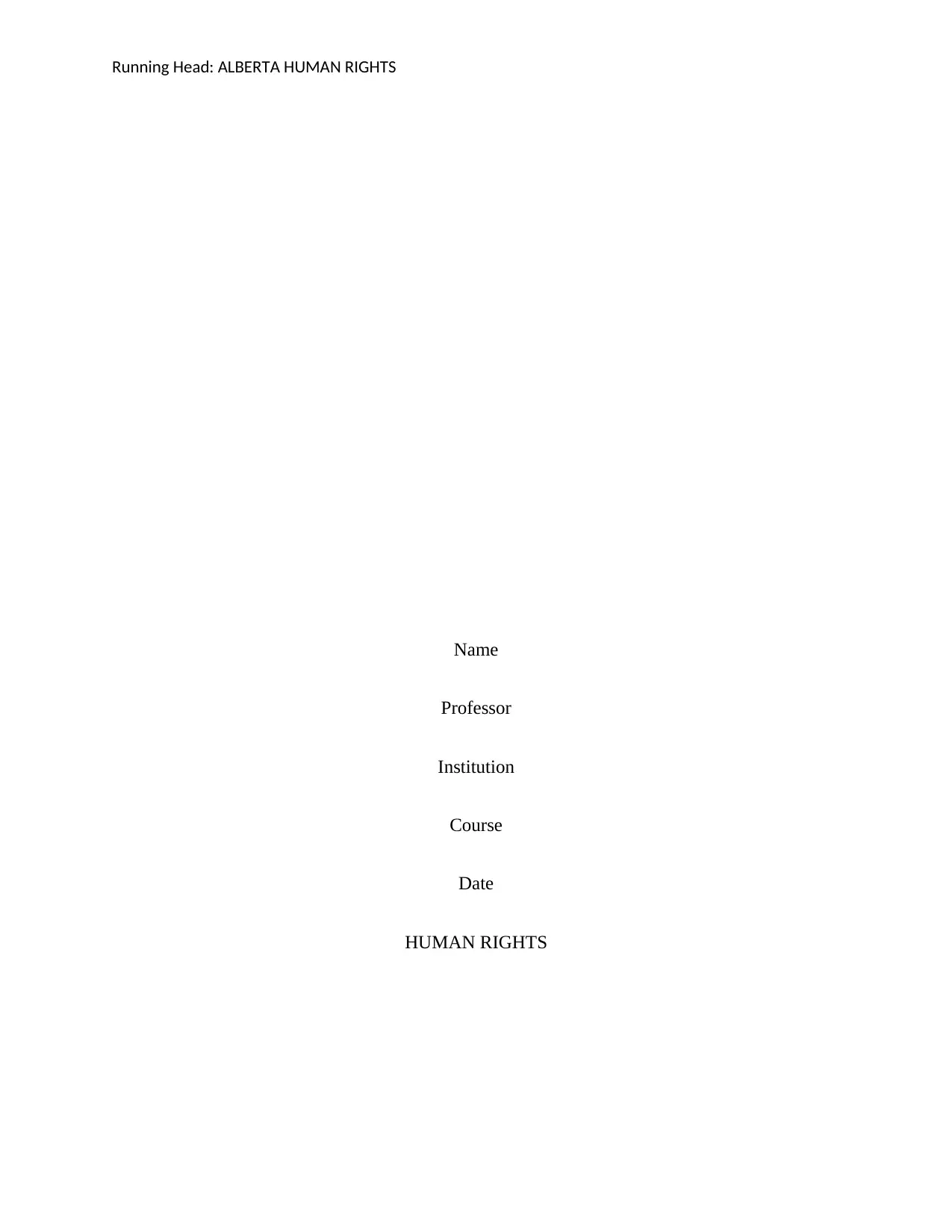
Running Head: ALBERTA HUMAN RIGHTS
Name
Professor
Institution
Course
Date
HUMAN RIGHTS
Name
Professor
Institution
Course
Date
HUMAN RIGHTS
Paraphrase This Document
Need a fresh take? Get an instant paraphrase of this document with our AI Paraphraser
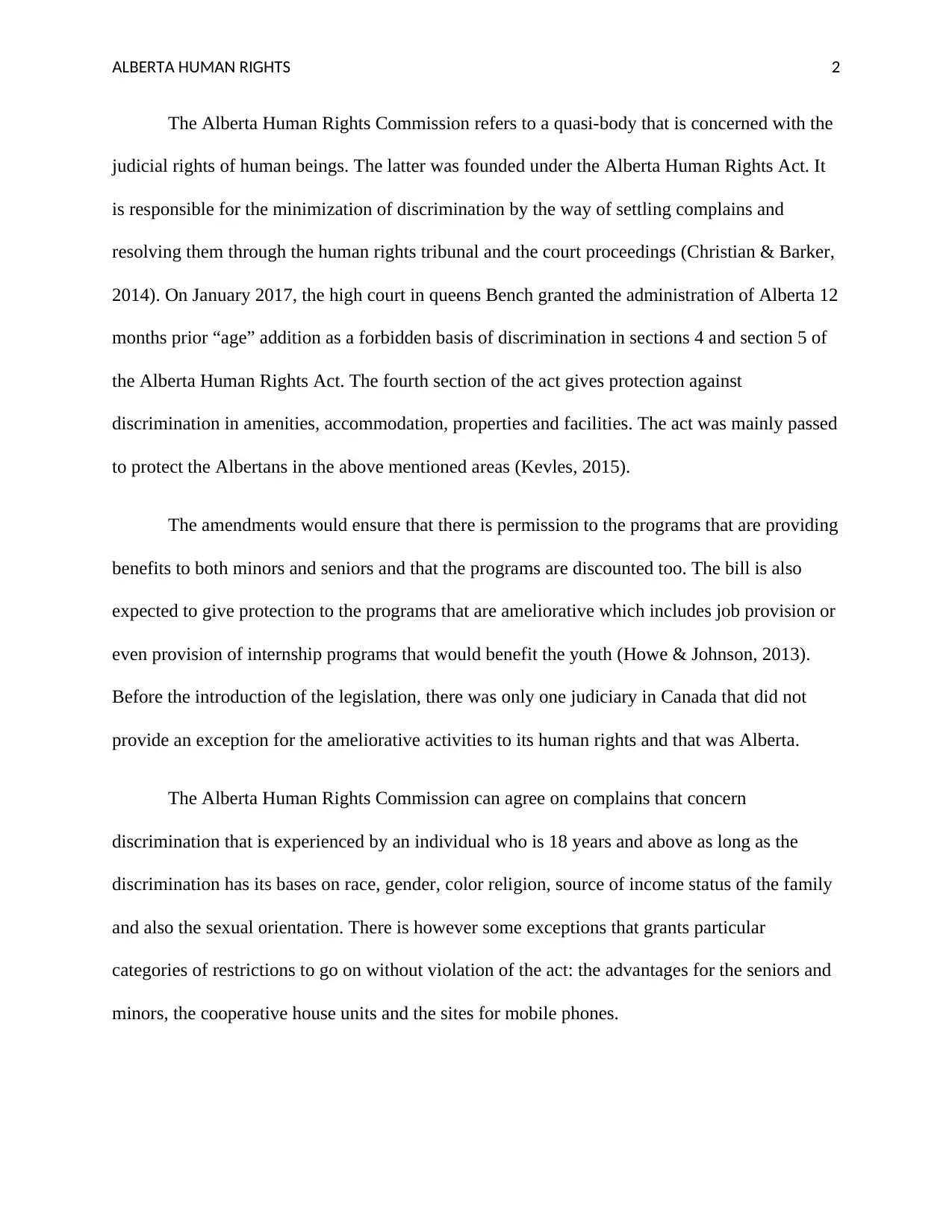
ALBERTA HUMAN RIGHTS 2
The Alberta Human Rights Commission refers to a quasi-body that is concerned with the
judicial rights of human beings. The latter was founded under the Alberta Human Rights Act. It
is responsible for the minimization of discrimination by the way of settling complains and
resolving them through the human rights tribunal and the court proceedings (Christian & Barker,
2014). On January 2017, the high court in queens Bench granted the administration of Alberta 12
months prior “age” addition as a forbidden basis of discrimination in sections 4 and section 5 of
the Alberta Human Rights Act. The fourth section of the act gives protection against
discrimination in amenities, accommodation, properties and facilities. The act was mainly passed
to protect the Albertans in the above mentioned areas (Kevles, 2015).
The amendments would ensure that there is permission to the programs that are providing
benefits to both minors and seniors and that the programs are discounted too. The bill is also
expected to give protection to the programs that are ameliorative which includes job provision or
even provision of internship programs that would benefit the youth (Howe & Johnson, 2013).
Before the introduction of the legislation, there was only one judiciary in Canada that did not
provide an exception for the ameliorative activities to its human rights and that was Alberta.
The Alberta Human Rights Commission can agree on complains that concern
discrimination that is experienced by an individual who is 18 years and above as long as the
discrimination has its bases on race, gender, color religion, source of income status of the family
and also the sexual orientation. There is however some exceptions that grants particular
categories of restrictions to go on without violation of the act: the advantages for the seniors and
minors, the cooperative house units and the sites for mobile phones.
The Alberta Human Rights Commission refers to a quasi-body that is concerned with the
judicial rights of human beings. The latter was founded under the Alberta Human Rights Act. It
is responsible for the minimization of discrimination by the way of settling complains and
resolving them through the human rights tribunal and the court proceedings (Christian & Barker,
2014). On January 2017, the high court in queens Bench granted the administration of Alberta 12
months prior “age” addition as a forbidden basis of discrimination in sections 4 and section 5 of
the Alberta Human Rights Act. The fourth section of the act gives protection against
discrimination in amenities, accommodation, properties and facilities. The act was mainly passed
to protect the Albertans in the above mentioned areas (Kevles, 2015).
The amendments would ensure that there is permission to the programs that are providing
benefits to both minors and seniors and that the programs are discounted too. The bill is also
expected to give protection to the programs that are ameliorative which includes job provision or
even provision of internship programs that would benefit the youth (Howe & Johnson, 2013).
Before the introduction of the legislation, there was only one judiciary in Canada that did not
provide an exception for the ameliorative activities to its human rights and that was Alberta.
The Alberta Human Rights Commission can agree on complains that concern
discrimination that is experienced by an individual who is 18 years and above as long as the
discrimination has its bases on race, gender, color religion, source of income status of the family
and also the sexual orientation. There is however some exceptions that grants particular
categories of restrictions to go on without violation of the act: the advantages for the seniors and
minors, the cooperative house units and the sites for mobile phones.
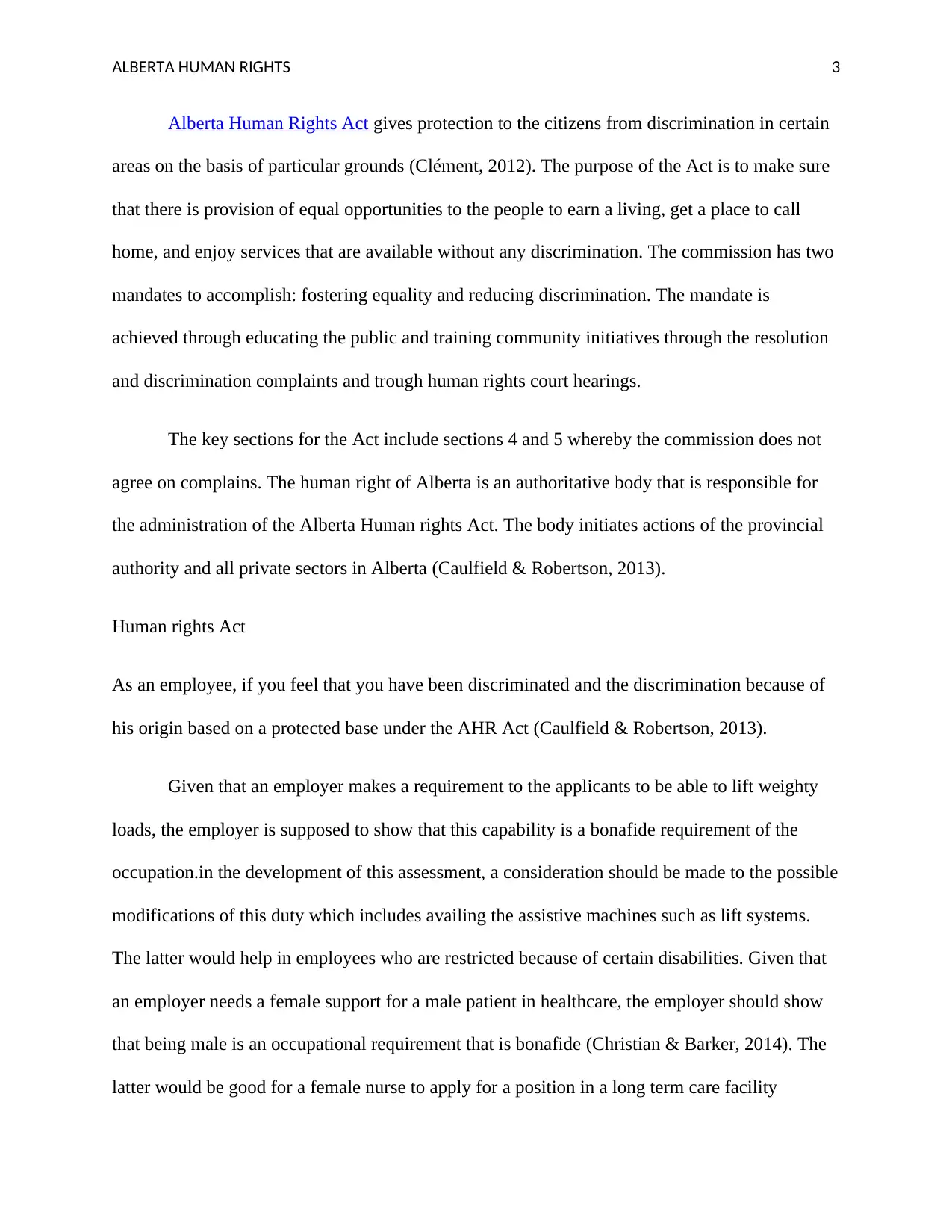
ALBERTA HUMAN RIGHTS 3
Alberta Human Rights Act gives protection to the citizens from discrimination in certain
areas on the basis of particular grounds (Clément, 2012). The purpose of the Act is to make sure
that there is provision of equal opportunities to the people to earn a living, get a place to call
home, and enjoy services that are available without any discrimination. The commission has two
mandates to accomplish: fostering equality and reducing discrimination. The mandate is
achieved through educating the public and training community initiatives through the resolution
and discrimination complaints and trough human rights court hearings.
The key sections for the Act include sections 4 and 5 whereby the commission does not
agree on complains. The human right of Alberta is an authoritative body that is responsible for
the administration of the Alberta Human rights Act. The body initiates actions of the provincial
authority and all private sectors in Alberta (Caulfield & Robertson, 2013).
Human rights Act
As an employee, if you feel that you have been discriminated and the discrimination because of
his origin based on a protected base under the AHR Act (Caulfield & Robertson, 2013).
Given that an employer makes a requirement to the applicants to be able to lift weighty
loads, the employer is supposed to show that this capability is a bonafide requirement of the
occupation.in the development of this assessment, a consideration should be made to the possible
modifications of this duty which includes availing the assistive machines such as lift systems.
The latter would help in employees who are restricted because of certain disabilities. Given that
an employer needs a female support for a male patient in healthcare, the employer should show
that being male is an occupational requirement that is bonafide (Christian & Barker, 2014). The
latter would be good for a female nurse to apply for a position in a long term care facility
Alberta Human Rights Act gives protection to the citizens from discrimination in certain
areas on the basis of particular grounds (Clément, 2012). The purpose of the Act is to make sure
that there is provision of equal opportunities to the people to earn a living, get a place to call
home, and enjoy services that are available without any discrimination. The commission has two
mandates to accomplish: fostering equality and reducing discrimination. The mandate is
achieved through educating the public and training community initiatives through the resolution
and discrimination complaints and trough human rights court hearings.
The key sections for the Act include sections 4 and 5 whereby the commission does not
agree on complains. The human right of Alberta is an authoritative body that is responsible for
the administration of the Alberta Human rights Act. The body initiates actions of the provincial
authority and all private sectors in Alberta (Caulfield & Robertson, 2013).
Human rights Act
As an employee, if you feel that you have been discriminated and the discrimination because of
his origin based on a protected base under the AHR Act (Caulfield & Robertson, 2013).
Given that an employer makes a requirement to the applicants to be able to lift weighty
loads, the employer is supposed to show that this capability is a bonafide requirement of the
occupation.in the development of this assessment, a consideration should be made to the possible
modifications of this duty which includes availing the assistive machines such as lift systems.
The latter would help in employees who are restricted because of certain disabilities. Given that
an employer needs a female support for a male patient in healthcare, the employer should show
that being male is an occupational requirement that is bonafide (Christian & Barker, 2014). The
latter would be good for a female nurse to apply for a position in a long term care facility
⊘ This is a preview!⊘
Do you want full access?
Subscribe today to unlock all pages.

Trusted by 1+ million students worldwide
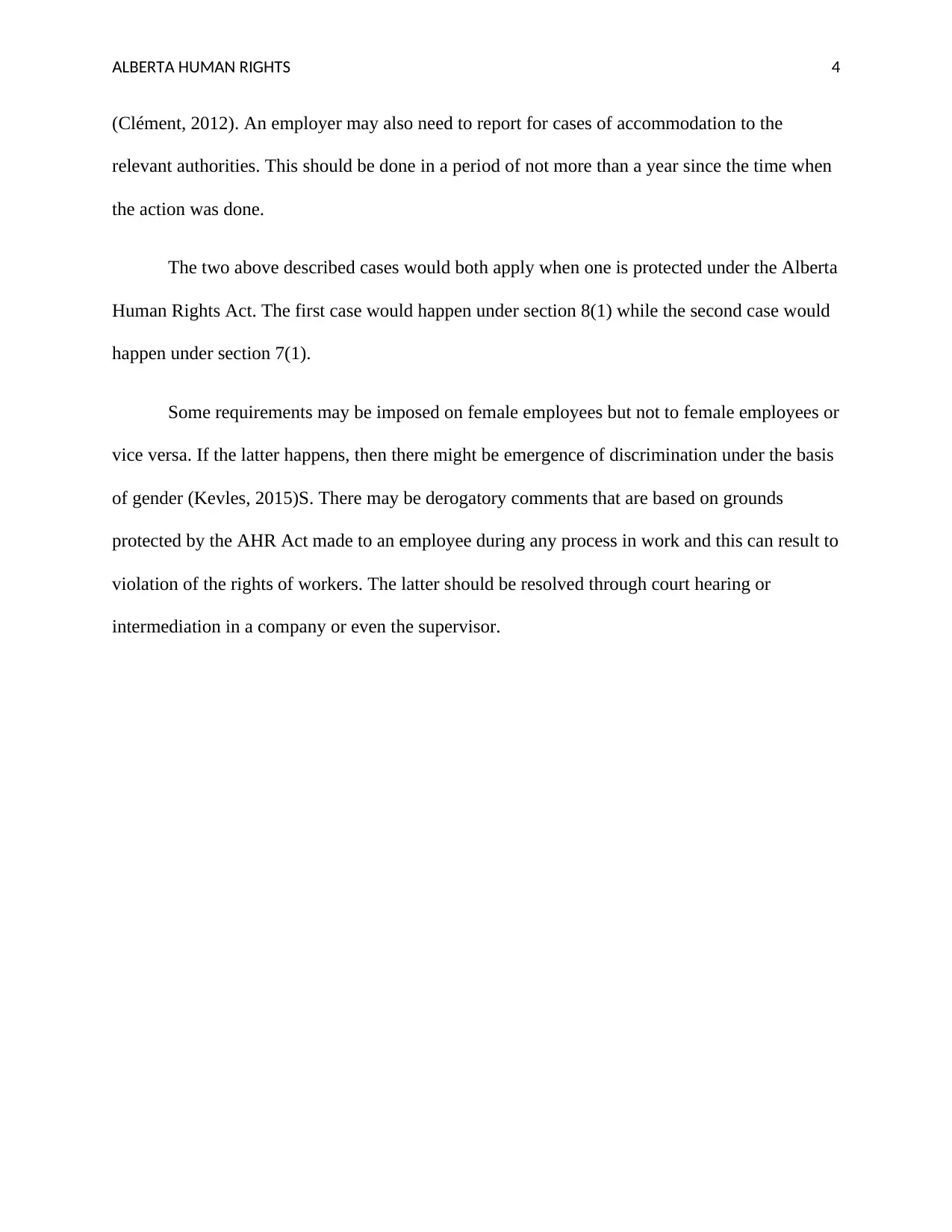
ALBERTA HUMAN RIGHTS 4
(Clément, 2012). An employer may also need to report for cases of accommodation to the
relevant authorities. This should be done in a period of not more than a year since the time when
the action was done.
The two above described cases would both apply when one is protected under the Alberta
Human Rights Act. The first case would happen under section 8(1) while the second case would
happen under section 7(1).
Some requirements may be imposed on female employees but not to female employees or
vice versa. If the latter happens, then there might be emergence of discrimination under the basis
of gender (Kevles, 2015)S. There may be derogatory comments that are based on grounds
protected by the AHR Act made to an employee during any process in work and this can result to
violation of the rights of workers. The latter should be resolved through court hearing or
intermediation in a company or even the supervisor.
(Clément, 2012). An employer may also need to report for cases of accommodation to the
relevant authorities. This should be done in a period of not more than a year since the time when
the action was done.
The two above described cases would both apply when one is protected under the Alberta
Human Rights Act. The first case would happen under section 8(1) while the second case would
happen under section 7(1).
Some requirements may be imposed on female employees but not to female employees or
vice versa. If the latter happens, then there might be emergence of discrimination under the basis
of gender (Kevles, 2015)S. There may be derogatory comments that are based on grounds
protected by the AHR Act made to an employee during any process in work and this can result to
violation of the rights of workers. The latter should be resolved through court hearing or
intermediation in a company or even the supervisor.
Paraphrase This Document
Need a fresh take? Get an instant paraphrase of this document with our AI Paraphraser
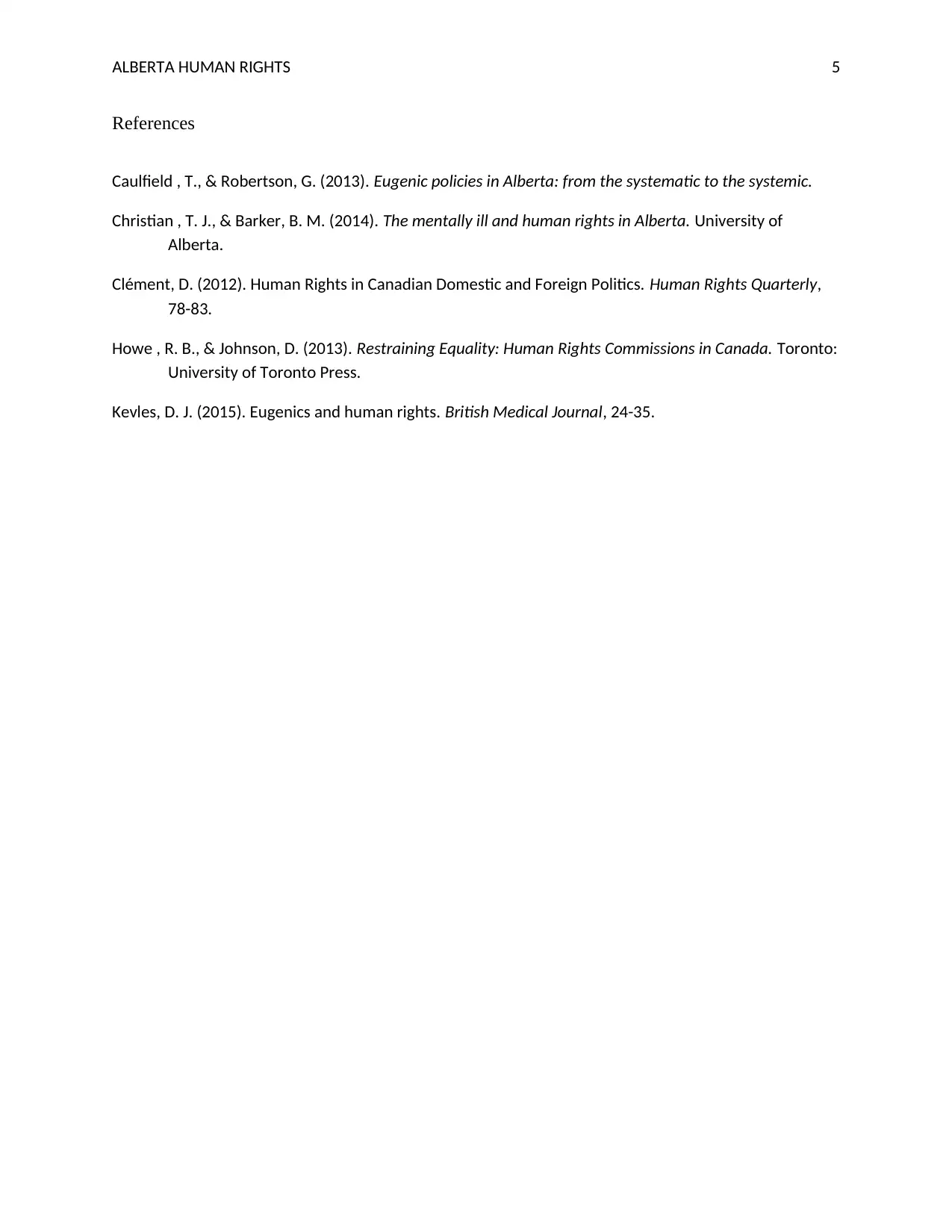
ALBERTA HUMAN RIGHTS 5
References
Caulfield , T., & Robertson, G. (2013). Eugenic policies in Alberta: from the systematic to the systemic.
Christian , T. J., & Barker, B. M. (2014). The mentally ill and human rights in Alberta. University of
Alberta.
Clément, D. (2012). Human Rights in Canadian Domestic and Foreign Politics. Human Rights Quarterly,
78-83.
Howe , R. B., & Johnson, D. (2013). Restraining Equality: Human Rights Commissions in Canada. Toronto:
University of Toronto Press.
Kevles, D. J. (2015). Eugenics and human rights. British Medical Journal, 24-35.
References
Caulfield , T., & Robertson, G. (2013). Eugenic policies in Alberta: from the systematic to the systemic.
Christian , T. J., & Barker, B. M. (2014). The mentally ill and human rights in Alberta. University of
Alberta.
Clément, D. (2012). Human Rights in Canadian Domestic and Foreign Politics. Human Rights Quarterly,
78-83.
Howe , R. B., & Johnson, D. (2013). Restraining Equality: Human Rights Commissions in Canada. Toronto:
University of Toronto Press.
Kevles, D. J. (2015). Eugenics and human rights. British Medical Journal, 24-35.
1 out of 5
Related Documents
Your All-in-One AI-Powered Toolkit for Academic Success.
+13062052269
info@desklib.com
Available 24*7 on WhatsApp / Email
![[object Object]](/_next/static/media/star-bottom.7253800d.svg)
Unlock your academic potential
Copyright © 2020–2025 A2Z Services. All Rights Reserved. Developed and managed by ZUCOL.





